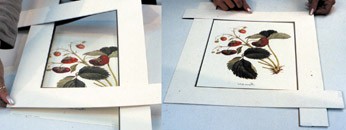The extensibles mount samples
A practical way to show customers how a picture will look once framed.

It is never easy to show customers how their pictures will look once framed. Usually framers use mount and frame corner samples for helping their customers to imagine how a framed picture will be.
But often corner samples are not an adequate solution for the customer is not a framer and does not have the framer’s familiarity with mount samples and moulding samples.
By putting samples near a picture a framer imagines right away how it will look once framed. For a customer it is never that easy.
In front of a customer
Let us see what happens in a shop when a customer has to choose mountboards. The picture lays on the counter. The framer takes a mount sample from his sample-case and places it on a corner of the picture.
Then he takes more samples and places them on the other corners of the picture in order to show the customer other possible options. If the framer wants to show how mountboards look with an internal fillet, he has to take from his set of samples both the mount corner sample and the fillet corner sample. He must firmly hold the two samples with his fingers in such a way that the internal fillet sticks out a few millimetres.
Then he must carefully lay the the samples on a corner of the picture without moving the internal fillet. If the same fillet sample has to be used with different mount samples, the framer needs to take it from the first mount sample and use it with the other ones. As the customer asks for more options the situation can become even more difficult and embarrassing for the framer.
At this point it is useful to underline that a mountboard with an internal fillet is more decorative and more pleasant than a mountboard without it. Thanks to the fillet the image stands out very well against the mountboard while the framed object looks more valuable.
Framers, therefore, should always propose mountboards with an internal fillet to their customers. For the framer this means also a higher price for the frame and an increase in his sales and profits.
The extensible mount samples
The Rinaldin firm has successfully tried a nice and simple way to help customers in choosing mountboards with a fillet: the extensible mount samples. This new method consists in using two long mount corner samples which include an internal fillet sticking out a few millimetres.
The two samples, which are at least 400 mm long on each side, are kept together by a joint (see the photo). Once placed on the picture they are extended or closed up until the entire picture fits inside.
Now the picture looks exactly as it will be once framed and the customer can clearly see it instead of only imagining it. At this point it is possible to place also the moulding corner samples for the customer to choose.
Eventually a plastic glass, which is safer than standard glass, can be put on the picture in order to give customers an even more realistic idea. Usually customers are satisfied by a frame which is presented in such a complete way and do not ask for more options.
The extensible mount samples could even have two fillets instead of one, while they would still be used as described above. In this case, though, the second fillet should be larger than the first one and should have the same colour of the mountboard (as shown in the photo).
Which colour combinations?
Compared to standard bevelled samples, extensible mount samples are bigger and take more space. Therefore framers who wish to save space should choose a limited number of samples. In this case it is better to choose only those with the most commonly used colours.
For the same reason it is better to keep inside the shop only a limited number of mountboard and fillet colour combinations. For a framer to limit the number of bevelled mount samples would have the advantage of reducing his own stock by keeping only the mountboards really requested by customers.
Several options are available for both the mountboard and the internal fillet. They can be made either of bevelled cardboard or of paperboard. An interesting combination can be obtained with a mount made of bevelled cardboard and the fillet made of paperboard like Nettuno, Acquerello and Splendorlux (manufactured by Fedrigoni) or Murillo (manufactured by Fabriano). In this case the fillet would cost less while giving the same aesthetic result.
In the experience of the Rinaldin firm, the mountboard and fillet colour combinations most commonly used are the following:
The container for extensible samples
Where and how to store the extensible mount samples?
The best solution is to keep them in storage cabinets with partition drawers. When looking for a specific sample it is possible to find it easily and quickly by reading the content labels on the drawers.
It would be suitable to have two sets of extensible mount samples, one for small pictures (up to 300x400 mm) and the other one for big pictures (up to 500x600 mm).
In case a customer’s picture is bigger than the extensible sample, the part of the picture contained inside the sample will be enough to give him a precise idea of how it will look once framed.
Each framer can easily make extensible mount samples by himself.
Anyway, framers who are short of time or prefer to buy them can order the extensible samples directly from the Rinaldin firm. It is also possible to order the cabinets for storing the samples. Please see the Rinaldin Catalogue 2002 for more details.